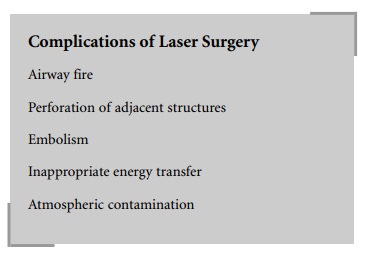Chapter: Clinical Cases in Anesthesia : Laser Laryngoscopy
What are the hazards of laser laryngoscopy to patients, operating room personnel, and anesthesia equipment?
What are the hazards of laser laryngoscopy to patients, operating
room personnel, and anesthesia equipment?
Administrative organizations have taken steps
to mini-mize laser-related problems. The US Food and Drug Administration (FDA),
the American National Standards Institute (ANSI), as well as the National Fire
Protection Association (NFPA) have developed rigorous safeguards to help
protect patients and operating room personnel from laser-device-related
injuries. The Occupational Health and Safety Administration (OSHA) has been
empowered to protect operating room personnel from laser injury. Most health
care facilities prohibit the use of lasers by uncreden-tialed practitioners.
One of the most dramatic and unique hazards of
laser laryngoscopy is airway fire. Ideally, anesthetic techniques should
minimize the risk of anesthetic gas combustion while providing adequate patient
oxygenation. Frequently, these goals are conflicting and difficult to achieve
because patients with the greatest need for laser laryngeal surgery often
present with compromised vital organ function. To further complicate matters,
these procedures are usually performed on an ambulatory basis.
Other laser hazards include unintentional
perforation of adjacent structures, embolic phenomena (usually occur-ring
during gynecologic surgery), inappropriate energy transfer, and atmospheric
contamination. Perforation of an adjacent structure may occur as an esophageal
perfora-tion during posterior laryngeal laser surgery. Inappropriate energy
transfer harms the patient or operating room personnel. Examples include
ignition of an endotracheal tube or surgical drapes. Avoiding such hazards
mandates depression of the laser foot pedal control only after aiming the
target light beam.
Atmospheric contamination may be the single
most common complication of laser surgery. Tissues vaporized by laser light
emit a plume of smoke containing pyrogens and other materials, such as viral
particles. These particles are released into the atmosphere and distributed to
exposed skin of the patient and operating room personnel. Therefore, total body
covering during laser procedures may be indicated. Operating room personnel
should wear specially designed facemasks that are resistant to the laser
plume’s particulate matter, in an effort to reduce the risk of dissemination
into the tracheobronchial tree.
Applying an aqueous-based lubricant, taping the
eyes closed, and covering with moist gauze or metallic eye shields may avoid
ocular damage to the patient. The patient’s face, head, and neck should be
surrounded with wet surgical towels to reduce the risk of ignition. Special
wrap-around goggles designed for each laser frequency are available to protect
the eyes of operating room personnel. Clear wrap-around goggles block
far-wavelength light associated with CO2 lasers. Specific
color-tinted goggles protect against near-wavelength lasers, such as the Nd-YAG
and argon lasers.

Lasers also jeopardize anesthesia equipment.
Errant beams have ignited endotracheal tubes. Polyvinyl chloride (PVC) tubes
burn most easily and consequently are least desirable for laser surgery. Red
rubber and silicon endotra-cheal tubes are not as highly combustible as PVC
types. Although metal tubes present the least combustion hazard, they do not
eliminate the risk entirely, since their cuffs may still ignite. Covering the
cuff with saline-soaked gauze and inflating it with saline instead of air
reduces the poten-tial for airway fire. Saline-soaked gauze can also be used to
protect nonoperative airway sites. Wrapping the anesthesia breathing circuit in
aluminum foil protects it from errant laser beams. The aluminum foil wrapping
should also include the CO2 sampling tubing, which is no less
com-bustible than the anesthesia circuit. Similarly, nonmetallic endotracheal
tubes may be surrounded with metallic tape. At the time of writing, only the
Mericel® laser guard wrap is FDA-approved among all commercially available
metal-lic wraps. Copper tape protects against CO2, argon, and the
KTP-Nd-YAG laser, but not the YAG laser alone. Metallic wraps increase the
endotracheal tube’s external diameter in some cases. A small number of
laser-shielded endotracheal tubes are offered for sale. One such tube consists
of aluminum powder in a silicon base. These tubes contain silicone cuffs which,
if ruptured, can propel silica into the distal trachea.
Related Topics